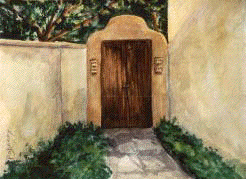|
|
|


"Baja Doorway"
Painted on location in San
Jose del Cobo, Baja Sur, Mexico
My goal in my watercolor workshops is that each student comes away with the sense that they have progressed in their skills as a watercolorist. I keep my classes fairly small so students of different levels can get individual instruction and not feel like they are being left behind. It is most important to me that all students have a fun, challenging experience.
There are some basic equipment you will need to bring to the workshop. The first and the most important is the paint. Try to buy the best quality watercolor paint that you can find. I prefer tube colors because they travel well and are easier to dispense and continue painting while on location.
The basic palette (group of colors) I use is burnt sienna, burnt umber, yellow ochre, cadmium yellow medium, cadmium yellow deep cadmium red medium, alizarin crimson, ultramarine blue, cerulean blue, viridian, hookers green, and Chinese white. To this palette I add other colors for certain subjects and locations. These colors may include thalos (green and blue), vermilion, scarlet lake, naples yellow, etc. I feel it is best though to establish a set palette, one with a good balance of warm and cool colors and become comfortable with those. I encourage my students to experiment with their palette and establish what the individual characteristic of their colors are. Are the individual colors transparent, semitransparent, or opaque? Are they staining, low staining, or non staining? In my technique where I "push and pull" my colors, lift and glaze, it is imperative that you know what a pigment or mixture of pigments will do in any given situation.
The easiest way to find out is to lay out a series of color swatches of the colors from your palette. These swatches should be the full range of a colors values (darkest dark to lightest light). When they are dry experiment with lifting the color with a damp brush and a tissue. How much white of the paper that is revealed will give you an idea of that colors characteristics.
Next on the list are brushes. It is possible to have too many brushes, and especially when going out on location. I keep my own brush selection to a minimum and have been using many of my brushes for most of my career. In choosing a brush look for quality first off. You don't want a brush that sheds or that the ferule (the metal part below the bristles) wobbles. As far as sizes and types, a nice simple group of brushes would include a large 1 1/2" - 2' flat for large washes, a 1" aquarelle for smaller washes, and a selection of rounds such as Nos. 4,6,8,10, and 14. There are interesting qualities to different brushes depending on manufacture, materials (such as sable, ox, or synthetic bristles), and age. Many of my older brushes have abilities that their maker never imagined. Get to know your brushes!
So now you have paint and brushes. That leaves paper on the list of basics. For painting en plein air I recommend buying blocks of watercolor paper. This eliminates having to transport and stretch individual sheets.
Watercolor paper comes in different surface textures, hot pressed, cold pressed, and rough. Each surface has its place and I encourage my students to become familiar with all the types. Smooth hot press paper is good for portraits and high detail paintings because the is relatively no
texture to the surface inhibit the smooth application of paint. Cold press has a slightly textured surface, and is a good all around watercolor paper. Cold press is what I usually choose for my outdoor and studio work. The rough is a specialized paper and is especially useful for painting "dry brush" scenes with water or wet streets etc.
I recommend that students bring two watercolor blocks, one cold press and one rough. Both 11x15